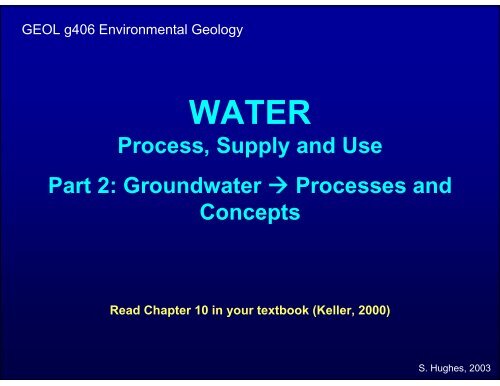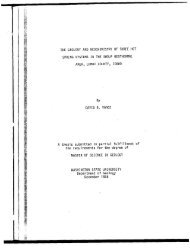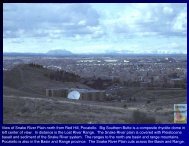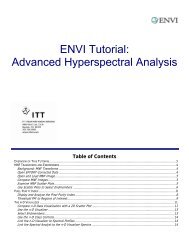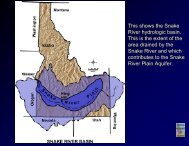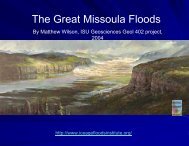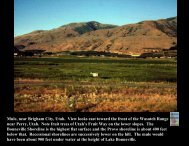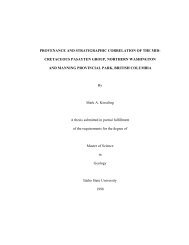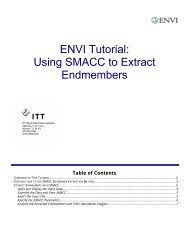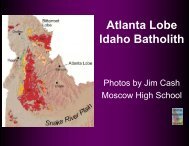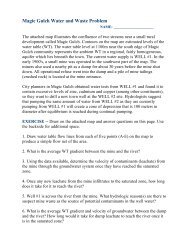covered in this module in pdf format
covered in this module in pdf format
covered in this module in pdf format
- No tags were found...
You also want an ePaper? Increase the reach of your titles
YUMPU automatically turns print PDFs into web optimized ePapers that Google loves.
Groundwater -- Recharge and Discharge• Water is cont<strong>in</strong>ually recycled through aquifer systems.• Groundwater recharge is any water added to the aquifer zone.• Processes that contribute to groundwater recharge <strong>in</strong>cludeprecipitation, streamflow, leakage (reservoirs, lakes,aqueducts), and artificial means (<strong>in</strong>jection wells).• Groundwater discharge is any process that removes waterfrom an aquifer system. Natural spr<strong>in</strong>gs and artificial wells areexamples of discharge processes.• Groundwater supplies 30% of the water present <strong>in</strong> ourstreams. Effluent streams act as discharge zones forgroundwater dur<strong>in</strong>g dry seasons. This phenomenon is known asbase flow. Groundwater overdraft reduces the base flow, whichresults <strong>in</strong> the reduction of water supplied to our streams.S. Hughes, 2003
PerennialStream(effluent)(from Keller, 2000,Figure 10.5a)• Humid climate• Flows all year -- fed by groundwater base flow (1)• Discharges groundwaterS. Hughes, 2003
EphemeralStream(<strong>in</strong>fluent)(from Keller, 2000,Figure 10.5b)• Semiarid or arid climate• Flows only dur<strong>in</strong>g wet periods (flashy runoff)• Recharges groundwaterS. Hughes, 2003
Groundwater -- Artesian Conditions•Water pressure <strong>in</strong> build<strong>in</strong>gs isma<strong>in</strong>ta<strong>in</strong>ed by a hydraulic head(h) and conf<strong>in</strong>ement of waterbeneath the pressure surface.•Natural artesian conditionsoccur when an aquifer isconf<strong>in</strong>ed by a saturated,impermeable clay layer (aquitardor aquiclude) below the slop<strong>in</strong>gpressure surface.•An artesian well flowscont<strong>in</strong>ually. It is produced when awell penetrates the clay layer andthe land surface is below thepressure surface.(from Keller, 2000, Figure 10.7)S. Hughes, 2003
Spr<strong>in</strong>gs(from Keller, 2000, Figure 10.8)Discharge of groundwaterfrom a spr<strong>in</strong>g <strong>in</strong> California.Spr<strong>in</strong>gs generally emerge atthe base of a hillslope.Some spr<strong>in</strong>gs produce waterthat has traveled for manykilometers; while others emitwater that has traveled onlya few meters.Spr<strong>in</strong>gs represent placeswhere the saturated zone(below the water table)comes <strong>in</strong> contact with theland surface.S. Hughes, 2003
Summary of Groundwater SystemsNOTE: Study each term, and the associated concepts andgeologic processes.(from Keller, 2000, Figure 10.9)S. Hughes, 2003
Groundwater Movement -- General ConceptsThe water table isactually a slop<strong>in</strong>gsurface.Slope (gradient) isdeterm<strong>in</strong>ed by thedifference <strong>in</strong> watertable elevation (h)over a specifieddistance (L).Direction of flow isdownslope.Flow rate depends onthe gradient and theproperties of theaquifer.(from Keller, 2000, Figure 10.6)S. Hughes, 2003
Groundwater MovementHYDRAULIC HEAD/ FLUID POTENTIAL = h (length units)• Measure of energy potential (essentially is a measure ofelevational/gravitational potential energy)• The driv<strong>in</strong>g force for groundwater flow• Water flows from high to low fluid potential or head (even if <strong>this</strong>means it may go "uphill"!)• Hydraulic head is used to determ<strong>in</strong>e the hydraulic gradientHydraulic head = the driv<strong>in</strong>g force that moves groundwater.The hydraulic head comb<strong>in</strong>es fluid pressure and gradient, andcan be though of as the stand<strong>in</strong>g elevation that water will rise to<strong>in</strong> a well allowed to come to equilibrium with the subsurface.Groundwater always moves from an area of higher hydraulichead to an area of lower hydraulic head. Therefore, groundwaternot only flows downward, it can also flow laterally or upward.S. Hughes, 2003
Groundwater MovementGeneral Concepts• Hydraulic gradient for anunconf<strong>in</strong>ed aquifer =approximately the slope ofthe water table.• Porosity = fraction (or %) of void space <strong>in</strong> rock or soil.• Permeability = Similar to hydraulic conductivity; a measure ofan earth material to transmit fluid, but only <strong>in</strong> terms of materialproperties, not fluid properties.• Hydraulic conductivity = ability of material to allow water tomove through it, expressed <strong>in</strong> terms of m/day (distance/time). Itis a function of the size and shape of particles, and the size,shape, and connectivity of pore spaces.S. Hughes, 2003
Groundwater MovementDeterm<strong>in</strong>e flow direction from well data:Well #1 4252’ elevdepth to WT = 120’Well #2 4315’ elev(WT elev = 4132’) depth to WT = 78’4180 4200 4220 4240(WT elev = 4237’)1. Calculate WT41404160418042003. Connectcontours ofequal elevation.4. Draw flow l<strong>in</strong>esperpendicular tocontours.4220424042604280Well #3 4397’ elevdepth to WT = 95’(WT elev = 4302’)426042804300elevations.2. Interpolatecontour<strong>in</strong>tervals.NS. Hughes, 2003
Groundwater Movement -- Cone of Depression(from Keller, 2000, Figure 10.10)Water tableflowflowCone of depressionPump<strong>in</strong>g water from a well causes a cone of depression toform <strong>in</strong> the water table at the well site.S. Hughes, 2003
Groundwater MovementPOROSITY = Φ or n (units - fraction or %)= fraction of void space (empty space) <strong>in</strong> soil or rock.Represents the path water molecules can follow <strong>in</strong> thesubsurfacePrimary porosity - <strong>in</strong>tergranularSecondary porosity - fractures, faults, cavities, etc.Porosity = volume of pore space relative to the total volume(rock and/or sediment + pore space). Primary porosity (%pore space) is the <strong>in</strong>itial void space present (<strong>in</strong>tergranular)when the rock formed. Secondary porosity (% added byopen<strong>in</strong>gs) develops later. It is the result of fractur<strong>in</strong>g, fault<strong>in</strong>g, ordissolution. Gra<strong>in</strong> shape and cementation also affect porosity.S. Hughes, 2003
Groundwater MovementPERMEABILITY is the capability of a rock to allow the passageof fluids. Permeability is dependent on the size of pore spacesand to what degree the pore spaces are connected. Gra<strong>in</strong> shape,gra<strong>in</strong> pack<strong>in</strong>g, and cementation affect permeability.SPECIFIC YIELD (S y ) is the ratio of the volume of water dra<strong>in</strong>edfrom a rock (due to gravity) to the total rock volume. Gra<strong>in</strong> sizehas a def<strong>in</strong>ite effect on specific yield. Smaller gra<strong>in</strong>s have largersurface area/volume ratio, which means more surface tension.F<strong>in</strong>e-gra<strong>in</strong>ed sediment will have a lower S y than coarse-gra<strong>in</strong>edsediment.SPECIFIC RETENTION (S r ) is the ratio of the volume of water arock can reta<strong>in</strong> (<strong>in</strong> spite of gravity) to the total volume of rock.Specific yield plus specific retention equals porosity (oftendesignated with the Greek letter phi):
Groundwater MovementMovement of groundwater depends on rock and sedimentproperties and the groundwater’s flow potential. Porosity,permeability, specific yield and specific retention are importantcomponents of hydraulic conductivity.HYDRAULIC CONDUCTIVITY = K (or P)units = length/time (m/day)Ability of a particular material to allow water to passthrough itThe def<strong>in</strong>ition of hydraulic conductivity (denoted "K" or "P" <strong>in</strong>hydrology formulas) is the rate at which water moves throughmaterial. Internal friction and the various paths water takes arefactors affect<strong>in</strong>g hydraulic conductivity. Hydraulic conductivity isgenerally expressed <strong>in</strong> meters per day.S. Hughes, 2003
WELL SORTEDCoarse (sand-gravel)POORLY SORTEDCoarse - F<strong>in</strong>eWELL SORTEDF<strong>in</strong>e (silt-clay)Permeability and Hydraulic ConductivityHighLowSort<strong>in</strong>g of material affects groundwater movement. Poorly sorted(well graded) material is less porous than well-sorted material.S. Hughes, 2003
Groundwater MovementTable 10.6 <strong>in</strong> textbook (Keller, 2000)Porosity and hydraulic conductivity of selected earth materialsHydraulicPorosity ConductivityMaterial (%) (m/day)UnconsolidatedClay 45 0.041Sand 35 32.8Gravel 25 205.0Gravel and sand 20 82.0RockSandstone 15 28.7Dense limestone or shale 5 0.041Granite 1 0.0041S. Hughes, 2003
Groundwater MovementThe tortuous path of groundwater molecules through anaquifer affects the hydraulic conductivity. How do the follow<strong>in</strong>gproperties contribute to the rate of water movement?• Clay content andadsorptive properties• Pack<strong>in</strong>g density• Friction• Surface tension• Preferred orientationof gra<strong>in</strong>s• Shape (angularity orroundness) of gra<strong>in</strong>s• Gra<strong>in</strong> size• Hydraulic gradientS. Hughes, 2003
Groundwater Flow NetsWater table contour l<strong>in</strong>es are similar to topographic l<strong>in</strong>es on amap. They essentially represent "elevations" <strong>in</strong> the subsurface.These elevations are the hydraulic head mentioned above.Water table contour l<strong>in</strong>es can be used to determ<strong>in</strong>e thedirection groundwater will flow <strong>in</strong> a given region. Many wellsare drilled and hydraulic head is measured <strong>in</strong> each one. Watertable contours (called equipotential l<strong>in</strong>es) are constructed tojo<strong>in</strong> areas of equal head. Groundwater flow l<strong>in</strong>es, whichrepresent the paths of groundwater downslope, are drawnperpendicular to the contour l<strong>in</strong>es.A map of groundwater contour l<strong>in</strong>es with groundwater flow l<strong>in</strong>esis called a flow net.Remember: groundwater always moves from an area of higherhydraulic head to an area of lower hydraulic head, andperpendicular to equipotential l<strong>in</strong>es.S. Hughes, 2003
Groundwater Flow Nets100 50QalA simple flow netCross-profile viewAquitard (granite)QalWTQalwellAquitard• Effect of aproduc<strong>in</strong>g well• Notice theapproximatediameter of thecone of depressionS. Hughes, 2003
Groundwater Flow NetsAquitard100 90 80Aquitard70QalWater table contoursWater is flow<strong>in</strong>g from Qalto granite100908070QalWater is flow<strong>in</strong>g fromgranite to QalDistorted contours mayoccur due to anisotropicconditions (changes <strong>in</strong>aquifer properties).Area of high permeability (high conductivity)S. Hughes, 2003
Groundwater Flow NetsWater table contours <strong>in</strong>DRAINAGEBASINWTcontoursFlow l<strong>in</strong>esNdra<strong>in</strong>age bas<strong>in</strong>s roughlyfollow the surfacetopography, but dependgreatly on the properties ofrock and soil that composethe aquifer:• Variations <strong>in</strong> m<strong>in</strong>eralogyand texture• Fractures and cavities• Impervious layers• ClimateDra<strong>in</strong>age bas<strong>in</strong>s are often used to collect clean,unpolluted water for domestic consumption.S. Hughes, 2003
Groundwater Flow Net414412410NWater Flow L<strong>in</strong>es408Water Table Contours406404Well402400
Groundwater Movement -- Darcy’s LawQ = KIA -- Henry Darcy, 1856, studied water flow<strong>in</strong>g throughporous material. His equation describes groundwater flow.Darcy’s experiment:• Water is applied underpressure through endA, flows through thepipe, and discharges atend B.• Water pressure ismeasured us<strong>in</strong>gpiezometer tubesHydraulic head = dh (change <strong>in</strong> height between A and B)Flow length = dL (distance between the two tubes)Hydraulic gradient (I) = dh / dLS. Hughes, 2003
Groundwater Movement -- Darcy’s LawThe velocity of groundwater is based on hydraulicconductivity (K), as well as the hydraulic head (I).The equation to describe the relations between subsurfacematerials and the movement of water through them isQ = KIAQ = Discharge = volumetric flow rate, volume of water flow<strong>in</strong>gthrough an aquifer per unit time (m 3 /day)A = Area through which the groundwater is flow<strong>in</strong>g, crosssectionalarea of flow (aquifer width x thickness, <strong>in</strong> m 2 )Rearrange the equation to Q/A = KI, known as the flux (v),which is an apparent velocityActual groundwater velocity is higher than that determ<strong>in</strong>edby Darcy’s Law.S. Hughes, 2003
Groundwater Movement -- Darcy’s LawFLUX given by v = Q/A = KI is the IDEAL velocity ofgroundwater; it assumes that water molecules can flow <strong>in</strong> astraight l<strong>in</strong>e through the subsurface.NOTE: Flux doesn't account for the water molecules actuallyfollow<strong>in</strong>g a tortuous path <strong>in</strong> and out of the pore spaces. Theytravel quite a bit farther and faster <strong>in</strong> reality than the flux would<strong>in</strong>dicate.DARCY FLUX given by vx = Q/An = KI/n (m/sec) is theACTUAL velocity of groundwater, which DOES account fortortuosity of flow paths by <strong>in</strong>clud<strong>in</strong>g porosity (n) <strong>in</strong> thecalculation. Darcy velocity is higher than ideal velocity.Darcy’s Law is used extensively <strong>in</strong> groundwater studies. It canhelp answer important questions such as the direction apollution plume is mov<strong>in</strong>g <strong>in</strong> an aquifer, and how fast it istravel<strong>in</strong>g.S. Hughes, 2003
Groundwater OverdraftOverpump<strong>in</strong>g will have two effects:1. Changes the groundwater flowdirection.2. Lowers the water table, mak<strong>in</strong>g itnecessary to dig a deeper well.• This is a lead<strong>in</strong>g cause fordesertification <strong>in</strong> some areas.• Orig<strong>in</strong>al land users and land ownersoften spend lots of money to drill new,deeper wells.• Streams become permanently dry.S. Hughes, 2003
Groundwater Overdraft• Almost half the U.S. population uses groundwater as aprimary source for dr<strong>in</strong>k<strong>in</strong>g water.• Groundwater accounts for ~20% of all water withdrawn forconsumption.• In many locations groundwater withdrawal exceeds naturalrecharge rates. This is known as overdraft.• In such areas, the water table is drawn down "permanently";therefore, groundwater is considered a nonrenewableresource.•The Ogallala aquifer underlies Midwestern states, <strong>in</strong>clud<strong>in</strong>gTexas, Oklahoma, and New Mexico, while California, Arizonaand Nevada use the Colorado River as their primary watersource. All show serious groundwater overdraft.S. Hughes, 2003
Groundwater Overdraft <strong>in</strong> the Conterm<strong>in</strong>ous U.S.(from Keller, 2000, Figure 10.13a)S. Hughes, 2003
• Water-level changes <strong>in</strong> theTexas--Oklahoma-High Pla<strong>in</strong>sarea.•The Ogallala aquifer --composed of water-bear<strong>in</strong>gsands and gravel that underlieabout 400,000 km 2 .• Water is be<strong>in</strong>g used forirrigation at a rate up to 20times more than naturalrecharge by <strong>in</strong>filtration.• Water level (water table) <strong>in</strong>many parts has decl<strong>in</strong>ed andthe resource eventually maybe used up.Groundwater Overdraft(from Keller, 2000, Figure 10.13b)S. Hughes, 2003
artesian aquiferaquifercone of depressionconf<strong>in</strong>ed aquiferDarcy's Law (all terms)dischargeeffluent streamflow l<strong>in</strong>esflow netgroundwaterhydraulic conductivityhydraulic gradienthydraulic head<strong>in</strong>filtration<strong>in</strong>fluent streamoverdraftGroundwater Termsoverland flowperched aquiferpermeabilityporesporosityrechargeresidence timesoil waterspecific retentionspecific yieldspr<strong>in</strong>gunconf<strong>in</strong>ed aquifervadose zonewater tablewater table contour l<strong>in</strong>esS. Hughes, 2003


